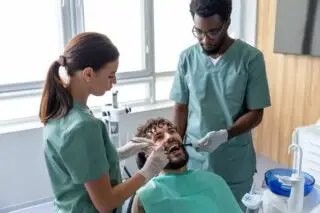As mentioned earlier, there are five main types of vaccines: attenuated (live) vaccines, inactivated vaccines, toxoid vaccines, subunit vaccines, and conjugate vaccines. The first vaccines for humans against viruses used weakened or attenuated viruses to generate immunity without causing serious illness (e.g. the early smallpox vaccine that was derived from cowpox). The rabies vaccine was the first human vaccine where the virus was attenuated in a laboratory. Let’s take a closer look at the list of vaccines according to vaccine type:
Live, attenuated vaccine list:
According to vaccines.gov, live-attenuated vaccines use a weakened form of the germ that causes a disease to assist in building immunity. Vaccines.org reports that just one or two doses of most live vaccines can give you a lifetime of protection against a germ and the disease it causes.
- Vaccinia (smallpox) There is a vaccine against smallpox that was a key tool in the eradication of the disease. This vaccine does not contain the variola virus which causes smallpox, but a closely related virus called vaccinia. Since smallpox was eradicated, the vaccine is not recommended in routine immunization. It is used to protect researchers who work on the variola virus that causes smallpox and other viruses in the same virus family (known as orthopox viruses). If there is a smallpox outbreak, public health officials will say who else should get the vaccine. The CDC works with federal, state, and local officials to prepare for a smallpox outbreak.
- Measles, mumps, rubella (MMR combined vaccine) The MMR combined vaccine is recommended for most people, according to the CDC. It protects against three diseases: Measles, mumps, and rubella. Per the CDC, it is safe and effective. Two doses of the MMR vaccine are about 97% effective while one dose is about 93% effective.
- Varicella (chickenpox) According to vaccines.gov, chickenpox used to be very common in the United States. But the good news is that the vaccine has greatly reduced the number of people who get it. The CDC recommends children should receive two doses of the vaccine — the first dose at 12 through 15 months old and a second dose at 4 through 6 years old.
- Influenza (nasal spray) The CDC has approved nasal flu spray for its use in non-pregnant individuals, 2 years through 49 years of age. Made from weakened flu viruses, your doctor sprays it into your nose. It protects you from the flu viruses that could make you sick during the upcoming flu season.
- Rotavirus Before rotavirus vaccines were available, rotavirus was the most common cause of severe gastroenteritis in infants and young children in the United States and worldwide. Rotavirus vaccines are live attenuated vaccines given by putting drops in a child’s mouth.
- Zoster (shingles) Almost 1 in 3 people will get shingles in their lifetime. The good news is that the shingles vaccine is more than 90% effective at preventing shingles. According to the CDC, two vaccines are licensed in the United States and recommended by the Advisory Committee on Immunization Practices (ACIP) to prevent shingles.
- Yellow fever A safe and effective yellow fever vaccine made from weakened virus has been available for more than 80 years. A single dose provides lifelong protection for most people. The yellow fever vaccine is only recommended for people living in or traveling to places where yellow fever is a risk — or for people who work in labs studying the virus.
Inactivated/killed vaccine list:
- Polio (IPV) According to WebMD, polio, or poliomyelitis, is a crippling and potentially deadly disease. The virus spreads from person to person and can invade an infected person’s brain and spinal cord, causing paralysis. If you had the polio vaccination prior to 2000, you may have received the oral polio vaccine (OPV), which was made from a live poliovirus. Although the live virus vaccine was highly effective at protecting against polio, a few cases of polio per year were caused by the oral vaccine itself. In 2000, the U.S. switched to the inactivated polio vaccine (IPV). Using an inactive (dead) form of the virus that cannot cause polio, the IPV is given as a shot in the arm or leg. The CDC reports that polio can be prevented with a vaccine. Inactivated polio vaccine (IPV) is the only polio vaccine that has been given in the United States since 2000. It is given by a shot in the arm or leg, depending on the person’s age. Oral polio vaccine (OPV) is used in other countries.
- Hepatitis A Medicinenet.com explains that the hepatitis A infection can be mild with no symptoms or a serious illness that can rarely cause liver failure and death. Getting vaccinated against the hepatitis A virus is the best way to prevent these problems. The hepatitis A vaccine does not cause hepatitis because it does not contain the live virus. It contains inactivated hepatitis A virus. The vaccine works by stimulating the body to produce antibodies, which are proteins that will fight and kill the virus and prevent hepatitis A infection. Hepatitis A vaccine is an inactivated (killed) vaccine. You will need 2 doses for long-lasting protection. These doses should be given at least 6 months apart. According to the CDC, Children are routinely vaccinated between their first and second birthdays (12 through 23 months of age). Older children and adolescents can get the vaccine after 23 months. Adults who have not been vaccinated previously and want to be protected against hepatitis A can also get the vaccine.
- Rabies The rabies vaccine is given to people who are at higher risk of coming in contact with rabies — like veterinarians. It’s also given to people after an animal bite if the animal could have rabies, says vaccines.gov. The rabies vaccine is made from killed rabies virus. It cannot cause rabies. Anyone who has been bitten by an animal, or who otherwise may have been exposed to rabies, should clean the wound and see a doctor immediately. The doctor will determine if they need to be vaccinated. According to the CDC, a person who is exposed and has never been vaccinated against rabies should get 4 doses of rabies vaccine – one dose right away, and additional doses on the 3rd, 7th, and 14th days. They should also get another shot called Rabies Immune Globulin at the same time as the first dose.
Toxoid (inactivated toxin) vaccine list:
Toxoid vaccines create immunity to the parts of the bacteria that cause the disease. That means the immune response is targeted to the toxin instead of the whole bacteria. Like some other types of vaccines, you may need booster shots to get ongoing protection against diseases.
- Diphtheria, tetanus (part of DTaP or DTP combined immunization) According to Children’s Hospital of Philadelphia, Diphtheria and tetanus are both caused by bacteria that make a harmful protein, called a toxin. People who develop an immune response to these toxins are protected against the disease. The diphtheria and tetanus vaccine is made by taking the diphtheria and tetanus toxins and inactivating them with a chemical. The inactivated toxins are called “toxoids.” Once injected, the toxoids causes an immune response to the toxins, but, unlike the toxin, it doesn’t cause disease. The World Health Organization relays that diphtheria and tetanus toxoids have been used combined with pertussis antigens and used as a combination DTP vaccine since the 1940s.
Subunit/conjugate vaccine list:
Subunit vaccines use only pieces of the pathogen to provoke an immune response. Conjugate vaccines are made using pieces from the coats of bacteria that are chemically linked to a carrier protein. This combination is used to create a more powerful, combined immune response. The piece of bacteria can’t cause illness, but combined with a carrier protein, it can generate immunity against future infection. Because these vaccines use only specific pieces of the germ, they give a very strong immune response that’s targeted to key parts of the germ. They can also be used on almost everyone who needs them, including people with weakened immune systems and long-term health problems. One limitation of these vaccines is that you may need booster shots to get ongoing protection against diseases.
- Hepatitis B According to vaccines.org, hepatitis B is a common disease in the United States. The good news is that the hepatitis B vaccine gives more than 90% protection to people who get the vaccine. There are 2 vaccines that protect against hepatitis B. The hepatitis B vaccine protects infants, children, and adults from hepatitis B. The hepatitis A and B combination vaccine protects adults from both hepatitis B and hepatitis A. Per HEPB.org, the hepatitis B vaccine is a safe and effective vaccine that is recommended for all infants at birth and for children up to 18 years. The hepatitis B vaccine is also recommended for adults living with diabetes and those at high risk for infection due to their jobs, lifestyle, living situations, or country of birth. Since everyone is at some risk, all adults should seriously consider getting the hepatitis B vaccine for lifetime protection against a preventable chronic liver disease. The hepatitis B vaccine is also known as the first “anti-cancer” vaccine because it prevents hepatitis B, the leading cause of liver cancer worldwide.
- Influenza (injection) There are many flu viruses, and they are always changing. According to the CDC, each year a new flu vaccine is made to protect against three or four viruses that are likely to cause disease in the upcoming flu season. But even when the vaccine doesn’t exactly match these viruses, it may still provide some protection. The flu shot is the best way to protect yourself and family from the flu, the CDC says. Live Science says strains of the flu virus are constantly changing, so a new flu vaccine is made each year. Scientists make the vaccine before the flu season starts by predicting which flu strains are likely to be the most common during the upcoming season.
- Haemophilus influenzae type b (Hib) The Hib vaccine is made from the sugar coating (polysaccharide) of the bacteria. Antibodies directed against the Hib polysaccharide protect the child against an infection that could result in permanent disabilities or death. Unfortunately, children less than 2 years old don’t develop very good immune responses to this polysaccharide, even if exposed to it through infection. For this reason, children less than 2 years old who catch Hib and survive the infection are still recommended to receive the Hib vaccine. Scientists have figured out that by taking the Hib polysaccharide and linking it to a harmless protein, young children are able to make a stronger immune response to the polysaccharide. This “conjugated” version of the Hib vaccine works extremely well. Before the vaccine, Hib caused about 25,000 cases of serious disease in the United States every year. In 2014, fewer than 10 cases of Hib in children 5 years of age and younger were reported to the CDC. The CDC recommends Hib vaccination for all children younger than 5 years old. Older children and adults usually do not need a Hib vaccine.
- Pertussis (part of DTaP combined immunization) DTaP is a vaccine that helps children younger than age 7 develop immunity to three deadly diseases caused by bacteria: diphtheria, tetanus, and whooping cough (pertussis). Tdap is a booster immunization given at age 11 that offers continued protection from those diseases for adolescents and adults. Both vaccines contain inactivated forms of the toxin produced by the bacteria that cause the three diseases. Inactivated means the substance no longer produces disease but does trigger the body to create antibodies that give it immunity against the toxins. DTaP is approved for children under age 7. Tdap, which has a reduced dose of diphtheria and pertussis vaccines, is approved for adolescents starting at age 11 and adults ages 19 to 64. It is often called a booster dose because it boosts the immunity that wanes from vaccines given at ages 4 to 6. Children should usually get 5 doses of DTaP vaccine, one dose at each of the following ages: 2 months, 4 months, 6 months, 15–18 months and 4–6 years. DTaP may be given at the same time as other vaccines. Also, sometimes a child can receive DTaP together with one or more other vaccines in a single shot.
- Pneumococcal The pneumococcal conjugate vaccine and the pneumococcal polysaccharide vaccine protect against pneumococcal infections, which are caused by bacteria.The CDC recommends the pneumococcal conjugate vaccine for all children younger than 2 years old, all adults 65 years or older, and people 2 through 64 years old with certain medical conditions. The CDC recommends pneumococcal polysaccharide vaccine for all adults 65 years or older, people 2 through 64 years old with certain medical conditions, and adults 19 through 64 years old who smoke cigarettes.
- Meningococcal Meningococcal disease can become life threatening quickly, and teens are at higher risk of getting it. It’s a leading cause of bacterial meningitis in teens. Meningitis is a dangerous inflammation of the lining of the brain and spinal cord. Two meningitis vaccines protects against four types of meningococcal disease. An additional type of vaccine protects against serotype B, which also causes meningitis. The CDC recommends routine meningococcal conjugate vaccination for: All preteens and teens at 11 to 12 years old with a booster dose at 16; and children and adults at increased risk for meningococcal disease.
- Human papillomavirus (HPV) The CDC recommends all boys and girls get two doses of the HPV vaccine at ages 11 or 12. HPV vaccination can be started at age 9. For the HPV vaccine to be most effective, the series should be given prior to exposure to HPV. The HPV vaccine is recommended at ages 11 to 12 to ensure children are protected long before they are ever exposed to the virus. Once someone is infected with HPV, the vaccine might not be as effective or might not work at all. Also, response to the vaccine is better at younger ages than it is at older ages. The CDC now recommends that all 11- and 12-year-olds receive two doses of HPV vaccine at least six months apart, instead of the previously recommended three-dose schedule. Younger adolescents ages 9 and 10 and teens ages 13 and 14 also are able to receive vaccination on the updated two-dose schedule. Research has shown that the two-dose schedule is effective for children under 15. Teens and young adults who begin the vaccine series later, at ages 15 through 26, should continue to receive three doses of the vaccine.
Additional Sources:



